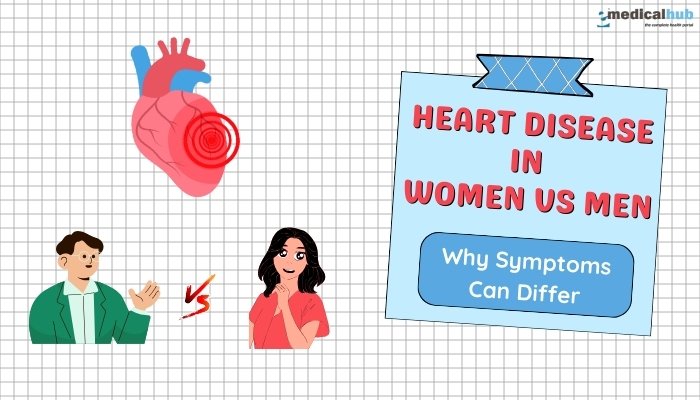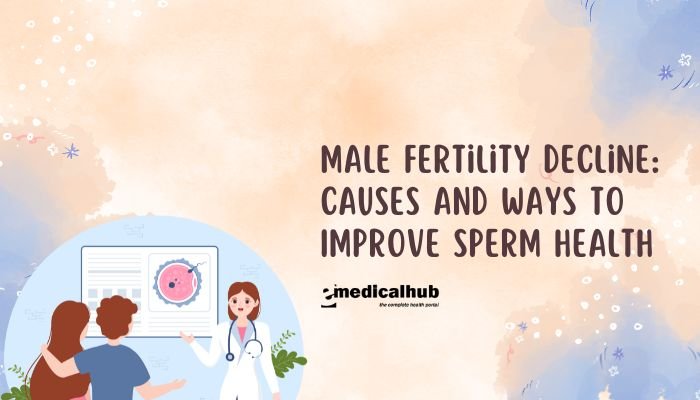Introduction
Heart disease ranks as a top cause of death for both women and men worldwide. Yet, the signs, risks, and outcomes can differ between these groups. For many years, heart disease was regarded as a condition that primarily affected men.
In reality, women also face substantial cardiovascular risk. Furthermore, symptoms in women sometimes do not match the classic heart attack warnings widely known from men’s experiences. This gap in understanding leads to delayed diagnosis and treatment.
This article explores the unique aspects of heart disease in women compared to men. It explains why these differences occur and what they mean for detection, prevention, and therapy.
The content aims to help readers identify subtle heart disease signs, recognize risk factors, and adopt protective measures. With clear headings and bullet points, the article highlights key points about the nature of heart disease in each sex and emphasizes methods to enhance awareness and health outcomes.
Understanding Heart Disease
Heart disease describes several conditions that affect how the heart functions. These include:
- Coronary Artery Disease (CAD): Narrowing or blockage of the vessels that supply the heart muscle with blood.
- Arrhythmias: Abnormal heart rhythms that disturb efficient blood pumping.
- Heart Failure: Reduced ability of the heart to pump blood.
- Valvular Heart Disease: Malfunction of the valves controlling blood flow through the heart’s chambers.
While many factors contribute to heart disease, the focus often falls on coronary artery disease and associated heart attacks. Plaque accumulation within arteries can limit blood flow to the heart. If a piece of plaque breaks off, forming a clot, a heart attack may follow. Differences in biology, hormones, and lifestyle lead to variations in how these processes manifest in women and men.
Why Symptoms Can Differ
Biological Differences
The female cardiovascular system has several distinctions. Women’s arteries can be smaller in diameter, making them more vulnerable to microvascular damage or spasms. Hormonal effects, such as estrogen’s protective action on blood vessels, also affect how disease develops. After menopause, when estrogen levels decline, women’s risk for coronary artery disease rises sharply. Additionally, certain inflammatory processes differ by sex, which influences how plaque forms and progresses.
Plaque Distribution
In many men, plaque forms in distinct areas within major arteries. This often leads to a recognizable pattern on imaging tests. Meanwhile, women sometimes develop plaque more diffusely throughout artery walls, including smaller vessels. This widespread, fine pattern of plaque can go undetected using standard tests designed primarily around male disease models.
Atypical Presentations
When men have a heart attack, they frequently describe intense chest pain or pressure that radiates to the arm or jaw. Many women can experience these classic signs too. However, women are also more likely to feel mild chest discomfort, fatigue, or indigestion-like pain, which may be dismissed as less urgent. They also experience sudden shortness of breath or back/neck pain more often than men. Such atypical symptoms cause confusion among patients and even healthcare professionals, delaying diagnosis and treatment.
Risk Factors for Women vs Men
Though both women and men share classic risk factors, such as high blood pressure or high cholesterol, women have additional concerns.
Common Shared Factors
- High Blood Pressure
Raises strain on artery walls, triggering plaque buildup. - High LDL Cholesterol
Contributes to plaque formation and artery narrowing. - Smoking
Harms artery linings and promotes clot formation. - Diabetes
Changes how the body processes fats and sugars, increasing heart disease risk. - Physical Inactivity
Leads to unhealthy weight gain and worsens metabolic issues. - Poor Diet
High intake of saturated fats, trans fats, and sugars drives plaque development. - Family History
Genes and shared lifestyles can raise risk in both sexes.
Women-Specific Risk Factors
- Hormonal Changes
Protective estrogen levels decline after menopause. Early menopause further raises the chance of heart disease. - Pregnancy-Related Complications
Conditions like gestational diabetes or preeclampsia signal higher cardiovascular risk later in life. - Polycystic Ovary Syndrome (PCOS)
Often linked to insulin resistance and metabolic problems, which can worsen cardiovascular health. - Autoimmune Disorders
Some autoimmune conditions occur more often in women and can damage blood vessels or increase clotting tendencies. - Stress and Depression
Women may experience these conditions differently, influencing blood pressure, inflammation, and overall health.
Men-Specific Risk Factors
- Earlier Onset
Men typically show heart disease symptoms at younger ages than women. - Higher Smoking Rates (Historically)
While smoking patterns shift over time, it has historically been more common in men, affecting risk. - Less Frequent Medical Visits
Men might be less inclined to see a healthcare provider regularly, delaying detection of high blood pressure or cholesterol.
Symptoms of Heart Disease in Women vs Men
Classic Heart Attack Symptoms in Men
- Intense chest pain or pressure (“elephant on the chest”)
- Pain that spreads to the left arm or jaw
- Sweating, nausea, or vomiting
- Lightheadedness
- Rapid heartbeat
Heart Attack Symptoms More Common in Women
- Mild or vague chest pain
- Shortness of breath, with or without chest discomfort
- Unusual fatigue, sometimes lasting days
- Upper back, neck, or shoulder pain
- Nausea, dizziness, or feeling faint
- Indigestion-like sensations
Though overlap exists, women are more prone to lesser-known or diffuse symptoms. This difference can slow down how quickly help is sought. Many women attribute their discomfort to acid reflux or muscle strain. By the time they realize it might be a heart problem, more damage may have occurred.
Microvascular Disease and Spasms
In addition to traditional artery blockages, women face higher rates of microvascular disease. This condition affects smaller arteries, reducing blood supply without forming large, stable plaques. Women are also more likely to experience coronary artery spasms, where blood vessels tighten briefly and restrict flow. Standard imaging may miss these issues, leading to a normal angiogram while the patient still suffers from symptoms. Proper identification often requires specialized tests.
Diagnostic Challenges
Doctors sometimes find it difficult to diagnose heart disease in women. Testing strategies typically evolved from male-focused studies, and standard screenings may not detect microvascular or diffuse plaques. Key obstacles include:
- Underreporting of Symptoms
Women might not mention mild chest discomfort or fatigue during short doctor visits. - Atypical Presentations
Unusual pain locations or intensities can mislead both patients and healthcare providers. - Less Aggressive Testing
A woman complaining of subtle symptoms may not be referred for thorough cardiac evaluation. - Inaccurate Stress Tests
Women sometimes have more false positives or negatives, making it harder to interpret standard exercises or imaging-based stress tests. - Societal Misconceptions
Many still see heart attacks as a “man’s disease,” so risk in women is undervalued.
The result is an unfortunate cycle: under-recognition of women’s heart disease leads to fewer targeted diagnostic methods and missed or delayed treatment. Healthcare providers who suspect microvascular dysfunction or spasms may need advanced imaging techniques, such as MRI or specialized tests evaluating blood flow in smaller vessels.
Treatment Variations and Outcomes
Medication Choices
Both women and men with heart disease typically receive medications such as:
- Statins: Lower cholesterol
- Beta-Blockers: Control heart rate and blood pressure
- ACE Inhibitors/ARBs: Relax vessels and protect the heart
- Antiplatelets: Reduce clot formation
However, differences in body size, hormone levels, or side-effect profiles can influence dosing. Women may experience more adverse reactions to certain drugs or skip medication due to pregnancy or childbearing concerns. Providers may need to tailor therapies carefully.
Procedures and Surgeries
Men historically undergo procedures like angioplasty or bypass surgery more often. Women, on average, might be older and sicker when they receive these interventions. Traditional stents or bypass grafts address blockages in large arteries, but microvascular disease remains harder to treat. Recovery can differ for women, possibly involving more complications or extended healing times.
Recovery and Rehabilitation
Cardiac rehabilitation is vital for both sexes after a heart event. It typically includes supervised exercise, diet counseling, and stress management. Yet, fewer women enroll in rehab programs than men. Reasons range from family obligations to limited awareness of such services. When women do attend, they can gain strength, reduce risk of future problems, and improve overall wellness at rates similar to men.
Survival Rates
Although men have historically shown higher numbers of heart disease deaths, women face worse survival odds when they do experience heart attacks. Some reasons include:
- Delayed care due to subtle symptoms
- Older age at onset
- More risk factors, including diabetes or hypertension
- Likely misdiagnosis or less aggressive treatment
Efforts to improve awareness and early detection can help close this gap.
Prevention Strategies
For Women
- Monitor Blood Pressure and Cholesterol
Schedule regular screenings, especially after menopause. - Be Alert to Changes
Note mild or vague symptoms that linger or worsen, such as fatigue or back pain. - Manage Pregnancy Complications
Preeclampsia or gestational diabetes can predict future risks. Follow up with a doctor. - Stay Physically Active
Walking, swimming, or other moderate exercises for at least 150 minutes a week can help. - Avoid Smoking
Quitting greatly reduces heart attack risk and improves blood vessel health. - Check Blood Sugar
Uncontrolled diabetes is more dangerous for women’s hearts than men’s.
For Men
- Routine Check-Ups
Visit healthcare providers for blood pressure, cholesterol, and weight checks. - Manage Stress
Chronic stress can heighten inflammation and blood pressure. - Limit Alcohol
Overuse contributes to hypertension and other heart problems. - Stay Active
Incorporate regular exercise to maintain healthy weight and good cardiac function. - Watch for Early Signs
If chest pain or tightness appears, do not dismiss it. Seek medical help.
Shared Approaches
- Healthy Diet
Emphasize fruits, vegetables, whole grains, lean proteins, and limited saturated or trans fats. - Weight Management
Excess weight burdens the heart and intensifies risk factors like diabetes or hypertension. - Control Chronic Conditions
Treat high blood pressure, high cholesterol, or diabetes diligently. - Regular Exercise
Helps maintain cardiovascular health, manage stress, and reduce obesity. - Stress Reduction
Techniques like deep breathing, meditation, or yoga can lower stress hormones that harm the heart.
Hormonal Influence
Estrogen plays a significant part in heart protection for premenopausal women. When estrogen levels fall during menopause, arteries can stiffen, and LDL may rise. At that point, a woman’s risk moves closer to that of men. Some women consider hormone replacement therapy (HRT) to address menopausal symptoms. However, HRT’s impact on heart health is complex. Although it may help some women with severe menopausal symptoms, it can increase blood clots or stroke risk in certain cases. Women should speak with healthcare providers about HRT’s possible benefits and risks.
Mental Health Connections
Depression, anxiety, and chronic stress can significantly affect heart health for both sexes. Studies indicate that women with depression can have a higher chance of heart attacks compared to men with the same condition. Factors contributing to depression—such as caregiving responsibilities or social stress—can worsen blood pressure, promote unhealthy coping (e.g., overeating), and raise inflammation. Addressing mental health needs becomes a crucial part of managing heart disease risk.
Societal and Cultural Factors
Social roles and cultural norms also shape heart disease outcomes:
- Caretaker Role
Women frequently manage family obligations, sometimes ignoring personal health. They might delay seeking care for heart symptoms until they finish caring for others. - Less Awareness of Risks
Some communities believe men are more likely to have heart trouble. Women’s episodes can go overlooked, leading to missed diagnoses. - Exercise Opportunities
In certain cultures, men might have more freedom to engage in sports or gym routines, while women’s activities can be restricted.
These barriers can be addressed with educational campaigns, community-based health initiatives, and gender-sensitive prevention programs.
Myths About Heart Disease in Women and Men
- Myth: Men are the only ones at serious risk of heart attacks.
Reality: Heart disease kills women in large numbers. - Myth: Women always experience the same chest pain as men.
- Reality: Women can present with subtle symptoms, like fatigue or indigestion.
- Myth: Hormone replacement therapy always protects the female heart.
Reality: HRT can be beneficial or harmful, depending on individual factors. - Myth: Young women do not get heart disease.
Reality: Women of any age can develop issues, especially if risk factors (e.g., genetics or smoking) are involved. - Myth: Heart disease is preventable by diet alone.
Reality: Although diet is crucial, exercise, genetic predispositions, and other factors matter, too. - Myth: Men are not at risk until middle age.
Reality: Even young men can develop heart disease, particularly with obesity, high stress, or inherited conditions.
Table: Key Differences in Heart Disease Between Women and Men
| Factor | Women | Men |
| Onset Age | Typically later, often post-menopause | Tends to appear earlier |
| Symptom Presentation | More likely atypical (fatigue, back pain, nausea) | Classic chest pain radiating to arm/jaw |
| Artery Blockage Pattern | Diffuse plaque, smaller vessels affected | Distinct plaque in major arteries |
| Diagnostic Challenges | Greater risk of missed diagnosis, microvascular | Often straightforward with stress tests/angiograms |
| Hormonal Influence | Estrogen protective until menopause | No estrogen advantage |
| Common Contributing Factors | Pregnancy complications, PCOS | Smoking, historically higher rates |
| Typical Severity at Diagnosis | Often older, multiple comorbidities | Can present with advanced disease but younger |
| Outcome of Heart Attack | Generally higher fatality rates, delayed care | Historically recognized, quicker intervention |
Special Considerations
Pregnancy and Heart Stress
Pregnancy places extra strain on the cardiovascular system. Blood volume rises, and the heart works harder. Women with pre-existing risk factors might develop gestational diabetes or preeclampsia, both of which can predict long-term heart problems. Monitoring blood pressure, controlling weight, and following up after pregnancy can reduce future complications.
Women with Autoimmune Diseases
Rheumatoid arthritis, lupus, and other inflammatory conditions raise heart disease risk significantly. These illnesses occur more often in women than in men. Chronic inflammation damages blood vessel linings and speeds plaque build-up. Regular cardiovascular check-ups are crucial for these patients.
Men’s Lifestyle-Related Habits
Men’s heart problems often emerge with high-stress jobs, poor diets, or consistent heavy drinking. Unmanaged anger or hostility might also spike blood pressure. Shifting toward balanced meals, stress management, and moderate alcohol use can help men avert heart disease or slow its progression.
Socioeconomic and Ethnic Variations
Ethnicity and socioeconomic background impact access to healthy foods, workout facilities, and quality healthcare. Some women in lower-income or minority groups have higher rates of obesity, hypertension, or diabetes but limited means to manage these. Similar disparities exist for men in underserved communities. Addressing these gaps by improving access to preventive care can lower heart disease rates across various populations.
Actionable Steps for Heart Health
- Early Screening
Both women and men should check blood pressure, cholesterol, and blood sugar regularly, starting in early adulthood. - Know the Warning Signs
Familiarize yourself with atypical symptoms in women and classic signs in men. Take any chest pain seriously. - Adopt a Balanced Diet
Limit processed foods. Emphasize fruits, vegetables, whole grains, lean proteins, and healthy fats. - Regular Exercise
Aim for at least 150 minutes of moderate-intensity activity weekly. Include strength training if possible. - Quit Tobacco
Smoking is a powerful risk factor for both sexes. Seek support to stop. - Track Weight
Carrying extra pounds strains the heart. Seek medical advice for healthy weight goals. - Manage Stress
Techniques like deep breathing, mindfulness, yoga, or counseling can help regulate blood pressure and heart rate. - Follow Doctor’s Advice
If prescribed medication, take it as directed and attend follow-up visits. - Seek Help Fast
If a potential heart attack occurs—whether it’s typical chest pain in men or vague discomfort in women—call emergency services immediately.
Conclusion
Heart disease affects everyone but can manifest differently in women and men. Biological, hormonal, and cultural factors shape not only the pattern of heart disease but also the symptoms, timing, and outcome.
Women may face more subtle warning signs, frequently receive later diagnoses, and have worse survival after certain heart events. Men often experience typical presentations at earlier ages. Understanding these differences is crucial for prompt and effective treatment.
Prevention strategies for heart disease overlap in both sexes: balanced nutrition, regular exercise, controlling chronic conditions, and quitting smoking. However, some groups—like women after pregnancy or men with stress-heavy lifestyles—require special attention. Medical professionals should be aware of microvascular changes, typical and atypical symptoms, and the need for thorough screening.
The entire community benefits when awareness is raised and timely steps are taken. With proper education and action, both women and men can adopt safer lifestyles and reduce their heart disease risks.
References
- Mosca L, Barrett-Connor E, Wenger NK. Sex/gender differences in cardiovascular disease prevention. Circulation. 2011;124(19):2145-54.
- Wenger NK. Women and coronary heart disease: a century after Herrick: understudied, underdiagnosed, and undertreated. Circulation. 2012;126(5):604-11.
- Garcia M, Mulvagh SL, Merz CN, et al. Cardiovascular disease in women: clinical perspectives. Circ Res. 2016;118(8):1273-93.
- Cho L, Davis M, Elgendy I, et al. Summary of updated recommendations for primary prevention of cardiovascular disease in women. J Am Coll Cardiol. 2020;75(11):1602-5.
- Mehta LS, Beckie TM, DeVon HA, et al. Acute myocardial infarction in women: a scientific statement from the American Heart Association. Circulation. 2016;133(9):916-47.
- Aggarwal NR, Patel HN, Mehta LS, et al. Sex differences in ischemic heart disease. Circulation. 2018;137(8):791-7.
- Tsao CW, Aday AW, Almarzooq ZI, et al. Heart disease and stroke statistics—2022 update: a report from the American Heart Association. Circulation. 2022;145(8):e153-e639.
- Gulati M, Shaw LJ, Bairey Merz CN. Myocardial ischemia in women: lessons from the NHLBI-sponsored Women’s Ischemia Syndrome Evaluation (WISE). J Am Coll Cardiol. 2009;54(17):1561-75.
- Pepine CJ, Anderson RD, Sharaf BL, et al. Coronary microvascular reactivity to adenosine in women with chest pain and normal coronary arteries: results from the NHLBI Women’s Ischemia Syndrome Evaluation (WISE). J Am Coll Cardiol. 2010;55(25):2825-32.
- Shaw LJ, Bugiardini R, Merz CN. Women and ischemic heart disease: evolving knowledge. J Am Coll Cardiol. 2009;54(17):1561-75.
- DeVon HA, Hogan N, Ochs AL, et al. Time to treatment for acute coronary syndromes: the impact of symptoms and the influence of gender. J Cardiovasc Nurs. 2010;25(2):106-14.
- Michos ED, Vaidya D. Sex differences in the prevention and management of cardiovascular disease. Eur Heart J. 2020;41(13):1328-36.




